» posted on Saturday, September 21st, 2013 by Linda Lou Burton
Smell The Smoke
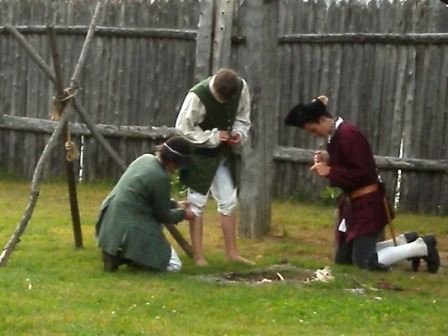 Linda Burton posting from Augusta, Maine – You can read the history books. Or you can smell the campfire smoke. Which is the better way to get a handle on the past? Dick Freeman, Chair of the Fort Western Board of Trustees, happened to be at the Fort today and talked with me after my tour; he believes we need a little of both. I smelled the smoke the minute I entered the Fort Western gate; three people in costume were just starting a fire for the afternoon demonstrations. The wisp of smoke eventually became a steady
Linda Burton posting from Augusta, Maine – You can read the history books. Or you can smell the campfire smoke. Which is the better way to get a handle on the past? Dick Freeman, Chair of the Fort Western Board of Trustees, happened to be at the Fort today and talked with me after my tour; he believes we need a little of both. I smelled the smoke the minute I entered the Fort Western gate; three people in costume were just starting a fire for the afternoon demonstrations. The wisp of smoke eventually became a steady 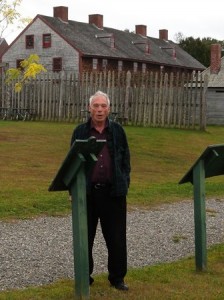 campfire; the warm smoky smell followed me the rest of the afternoon as I walked around the Fort. You know how smoke gets into your clothes; it even followed me back to my hotel. So did the stories, and images, from the Fort; I wondered if that happens with the school children who visit. They offer 17 programs to help students in grades K-12 meet selected Maine social studies standards through a visit to the Fort, or through classroom study of what happened there; they cover civics, government, citizen participation, economics, history, geography, and individual
campfire; the warm smoky smell followed me the rest of the afternoon as I walked around the Fort. You know how smoke gets into your clothes; it even followed me back to my hotel. So did the stories, and images, from the Fort; I wondered if that happens with the school children who visit. They offer 17 programs to help students in grades K-12 meet selected Maine social studies standards through a visit to the Fort, or through classroom study of what happened there; they cover civics, government, citizen participation, economics, history, geography, and individual  connections. Marjorie Dearborn, in costume, was my tour guide today. “The building has been restored to the time when it served as a store, and a home for the Howard family,” she explained. We looked at the merchandise on the shelves; the shoes that were made to fit either foot; the ledger that contained an entry for every item sold. In April 1774 someone bought nutmeg, and sugar and salt; in May there was a purchase of chocolate, and women’s shoes; in August it was coffee, and corn; in October Daniel Townsend bought 2 quarts of rum. Back in my room, with the smell of smoke still clinging to my clothes; I began to read the history.
connections. Marjorie Dearborn, in costume, was my tour guide today. “The building has been restored to the time when it served as a store, and a home for the Howard family,” she explained. We looked at the merchandise on the shelves; the shoes that were made to fit either foot; the ledger that contained an entry for every item sold. In April 1774 someone bought nutmeg, and sugar and salt; in May there was a purchase of chocolate, and women’s shoes; in August it was coffee, and corn; in October Daniel Townsend bought 2 quarts of rum. Back in my room, with the smell of smoke still clinging to my clothes; I began to read the history.
The History of the Fort. Fort Western was built in 1754 by Kennebec Proprietors of Boston. The lands along the Kennebec River had been granted to the Pilgrims more than a century earlier, but conflict was common between England and France in the 1600-1700s. The French could easily travel along Quebec’s Chaudière River to the English lands along the Kennebec, and when hostilities erupted again in 1753, the Province of Massachusetts ordered the construction of Fort Halifax near what is now Winslow, Maine (remember, the land that now is Maine was part of Massachusetts at the time). This was a strategic move to defend the upper Kennebec River Valley from possible attack by the French and their allies, the native Abenaki. Fort Halifax, however, was about 17 miles north of a navigable point on the river, so Fort Western was  built as a “fortified storehouse,” to support Fort Halifax. Supplies were shipped via sloop and schooner up the Kennebec from Boston, unloaded at Fort Western, then taken by flat-bottomed boat past the rocky shoals the remaining 17 miles to Fort Halifax.
built as a “fortified storehouse,” to support Fort Halifax. Supplies were shipped via sloop and schooner up the Kennebec from Boston, unloaded at Fort Western, then taken by flat-bottomed boat past the rocky shoals the remaining 17 miles to Fort Halifax.
Captain James Howard, who was stationed at Fort Richmond further south on the river, was selected to be in charge at Fort Western; he, his sons, and 15 men moved into the storehouse when it was completed in October 1754. Protected behind its four-pound cannon, the garrison spent most of its time doing routine duty, including boat repair, cooking, baking, brewing, and getting wood, in addition to delivering supplies to Fort Halifax.
Fort Western was never attacked directly, although one man was captured in 1755 as he attempted to deliver dispatches to Fort Halifax; other garrison members were fired upon as they returned a boat to Fort Halifax in 1757. Hostilities on the Kennebec came to a virtual 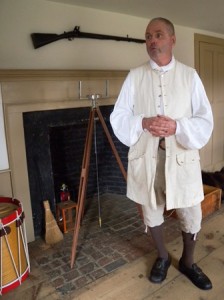 end in 1760 but the garrison at Fort Western stayed on station another seven years to help maintain an English presence on the river. When the last of the garrison was discharged, Captain Howard made arrangements to acquire the Fort’s buildings and surrounding lands.
end in 1760 but the garrison at Fort Western stayed on station another seven years to help maintain an English presence on the river. When the last of the garrison was discharged, Captain Howard made arrangements to acquire the Fort’s buildings and surrounding lands.
Note: Benedict Arnold used Fort Western as a staging point for his assault on Quebec in 1775 during the American Revolution; he stayed in the area for a week or more as his bateaux were completed and supplies loaded. Some of Arnold’s officers, including Daniel Morgan, Aaron Burr, and Henry Dearborn lodged in the Fort’s main house. But no soldiers were stationed at Fort Western after 1767; its future played out as a civilian store and private residence.
The History of the Store and House. The end of the colonial wars brought a flood of mostly English-speaking settlers to the Kennebec Valley. James Howard, former Captain but now local leader, opened a store in what had been the military storehouse. For the next 50 years, this store was the center of trade between new settlers on the Kennebec, Boston, Newfoundland, and the West Indies.
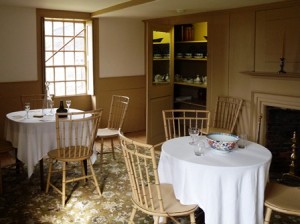 James Howard was a family man, and when his sons came of age, they remodeled the north half of the main house, making eight finished rooms out of the former barracks area. William Howard was the first to take up residence, moving in with his wife Martha about 1770. With him came his brother, John Howard. A third brother, Samuel Howard, became a main house resident when he moved from Boston to the Kennebec following the closure of the port of Boston in 1774. Together he and William formed the storekeeping firm of S&W Howard. William Howard stayed at the Fort and ran the store. Samuel sailed one of the family’s sloops between the Kennebec and Boston. The brothers also were important players in local, county, and state politics and invested in many public improvements. A steady stream of extended family members plus farm workers, housekeepers, Augusta’s first minister, and others stayed at the house and would have been considered part of the Howard household.
James Howard was a family man, and when his sons came of age, they remodeled the north half of the main house, making eight finished rooms out of the former barracks area. William Howard was the first to take up residence, moving in with his wife Martha about 1770. With him came his brother, John Howard. A third brother, Samuel Howard, became a main house resident when he moved from Boston to the Kennebec following the closure of the port of Boston in 1774. Together he and William formed the storekeeping firm of S&W Howard. William Howard stayed at the Fort and ran the store. Samuel sailed one of the family’s sloops between the Kennebec and Boston. The brothers also were important players in local, county, and state politics and invested in many public improvements. A steady stream of extended family members plus farm workers, housekeepers, Augusta’s first minister, and others stayed at the house and would have been considered part of the Howard household.
What You See Today.  On the store exhibit shelves are hundreds of items documented in store account books, in store newspaper ads from the Kennebec newspapers of the 1790’s and early 1800’s, and on the 1799 probate inventory of store partner Samuel Howard.
On the store exhibit shelves are hundreds of items documented in store account books, in store newspaper ads from the Kennebec newspapers of the 1790’s and early 1800’s, and on the 1799 probate inventory of store partner Samuel Howard.
There to see is an amazing assemblage of English, West Indies, and Kennebec goods – farming and forestry tools, a wide variety of ceramics and crockery ware, the latest in tea sets and tableware, buckets, shoes, and hardware. Also exhibited are sword knots and sashes for the local militia, pocket knives and razors, andirons, shovels, tongs, fishhooks, pails, and window glass. There are casks of pork, beef and fish; boxes of tea, raisins, and chocolate; bags of feathers; barrels of flour and bread; and sides of sole and upper leather. At the back of the store are examples of many of the items that store customers used in place of cash during the age of barter. Included are bundles of shingles, red oak and white oak staves for barrels and hogsheads, barrel heading and hoop stock, boards and planks, and the pelts of beaver, muskrats, foxes, sables, minks, bear, and moose.
The house exhibit is furnished based on the probate inventory taken upon the death of Samuel Howard in 1799. This inventory-based approach shows the main house at it may have 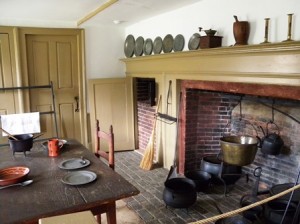 appeared prior to William Howard’s death in 1810. Since 1992, Old Fort Western has acquired or borrowed several pieces of furniture, glass, and ceramics actually inventoried by the probate court appraisers in 1799.
appeared prior to William Howard’s death in 1810. Since 1992, Old Fort Western has acquired or borrowed several pieces of furniture, glass, and ceramics actually inventoried by the probate court appraisers in 1799.
The kitchen was the last room I toured with Marjorie today after we walked through the store, the parlor, and the dining rooms with tables set; she put one of the big iron pots into my hand so I could feel the weight of it. The fireplace and bake oven were built by Samuel Oldham, a mason hired by the Kennebec Proprietors in late 1754. The soldiers who were stationed here as well as the members of the Howard family cooked on this hearth. The connections are made; the sights I saw match up with the history I read.
Martha Howard has dinner on the fire; I can smell the smoke.
Visit Old Fort Western, 16 Cony Street, Augusta, call for hours 207- 626-2385, http://www.oldfortwestern.org/index.asp
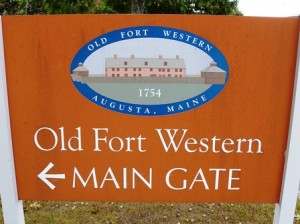 Note: Old Fort Western is now owned by the City of Augusta. It relies on the support of members, donors and friends to maintain its grounds and educational programs. I include Membership Information for those who wish to join. Friends receive unlimited free admission, are sent the Fort’s quarterly newsletter by mail, and earn discounts in the Fort’s gift shop. Friends may choose to join at one of the following levels:
Note: Old Fort Western is now owned by the City of Augusta. It relies on the support of members, donors and friends to maintain its grounds and educational programs. I include Membership Information for those who wish to join. Friends receive unlimited free admission, are sent the Fort’s quarterly newsletter by mail, and earn discounts in the Fort’s gift shop. Friends may choose to join at one of the following levels:
- Beverly Hewins Society: $25 to $99. Ms Hewins expressed her friendship by helping to form the first board of trustees in 1958 and then took the lead in building the Fort’s collections.
- Robert Hotelling Society: $100 to $299. Robert’s vision during the 1980s of a restored Fort Western in a new City Center complex was largely responsible for the historic and support facilities that make possible all we do today.
- Mary Maher McCarthy Society: $300 to $499. Mary was the best of Friends as the City of Augusta celebrated its bicentennial in 1997 and then when Fort Western marked its 250th anniversary in 2004.
- Gannett Society: $500 to $999. William Howard Gannett and Guy Patterson Gannett used their own funds to restore Fort Western at a time when historic preservation was a new idea and thus, in the spirit of true friendship, gave us all a gift of lasting importance.
To become a Friend of Old Fort Western contact: Old Fort Western, 16 Cony Street, Augusta, ME 04330, 207- 626-2385, oldfort@oldfortwestern.org
